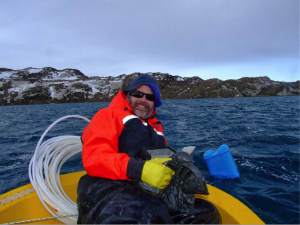Recently sequenced microbes living in Deep Lake are mostly specialists, cornering different niches in the lake ecosystem
The Science:
Four microbes dominate in the Antarctica’s Deep Lake, making up 70% of the microbial community. They belong to a group called haloarchaea that require high salt concentrations to grow and are naturally adapted to extreme conditions that would prove lethally cold to other organisms. The research team found that three of the four haloarchaea are adapted to niche environments within the lake. One, Halorubrum lacusprofundi, was more of a versatile generalist, tolerating a broader range of environments.

Study senior author Rick Cavicchioli sampling from the deepest point of Antarctica’s Deep Lake. (Image courtesy of R. Cavicchioli)
The Impact:
Understanding how haloarchaea thrive in extreme polar niches could be used to improve situations such as for cleaning up contaminated sites in permanently or seasonally cold regions. The genes that allow them to adapt to select conditions can be re-tooled for use in industrial or environmental remediation settings.
Summary
Deep Lake is a frigid, salty lake in Antarctica with a relatively homogenous microbial community. Microbes in the lake must weather extremes of light availability (all-day light in summer and zero light in winter and lack of nutrients. Life moves slowly in Deep Lake, with only six generations of cell division annually. (In contrast, under ideal conditions, the bacteria Escherichia coli can reproduce in 20 minutes). Four haloarchaea dominate and in a paper published February 20 in the ISME Journal, researchers describe the relative niches that these microbes have carved out for themselves.
The most abundant of the four, strain tADL (44% of the lake community) has several genes that probably give it an edge. It’s has genes for light harvesting and gas vesicles that help it float near the light-rich surface. The researchers note in the paper that “the genomic evidence indicates that tADL has a ‘sweet tooth’” because it’s especially good at metabolizing sugars and acids.
The second most abundant haloarchaea, strain DL31 (18% of the community) has a very different survival strategy. It lacks genes for both swimming and gas vesicles, but appears to be adept at metabolizing proteins and peptides. It’s also the only one of the four that doesn’t have genes for either gas vesicles or flagella. H. lacusprofundi (10% of the lake community) is the generalist among the four that can feed on a variety of nutrients. The least abundant, strain DL1 (0.3% of the lake community) shows a taste for amino acids and is the only one without genes for using glycerol as a nutrient.
The next step for the researchers is to use metaproteomics (study of proteins in an environmental sample) to investigate whether protein abundance in Deep Lake support their hypothesis about niche specialization.
Contact
Nikos Kyrpides
DOE JGI
[email protected]
Publication
Williams TJ et al. Microbial ecology of an Antarctic hypersaline lake: genomic assessment of ecophysiology among dominant haloarchaea. ISME J. 2014 Feb 20. doi: 10.1038/ismej.2014.18.
Funding
- Department of Energy, Office of Science
- Australian Research Council
- Australian Antarctic Science Program
Related Links
http://www.nature.com/ismej/journal/vaop/ncurrent/full/ismej201418a.html